Utah County Birders Newsletter
|
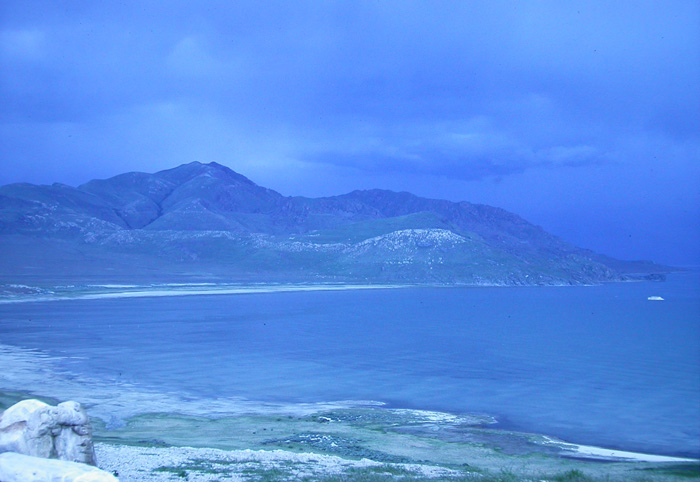 |
|
Antelope Island State Park |
1. Antelope Island State Park and Causeway
Nothing matches the spectacle of seeing hundreds of thousands of Eared Grebes and Wilson's Phalaropes feeding on the Gt. Salt Lake. Thousands of American Avocets, and hundreds of assorted other shore birds like the Black-necked Stilt and Western Sandpipers can be observed during spring and fall migrations. Impressive numbers of Black-bellied Plovers, Sanderlings, and Bonaparte's Gulls can be observed during migration as well. It is like no other experience you can have in Utah in terms of total numbers of birds. There is a nominal fee since it is a state park.
Since you are this close to Antelope Island you might as well continue your trip to the island and look for Chukar, Burrowing Owl, Barn Owl, and Grasshopper Sparrow. At Garr Ranch, farther south from the visitor's center, especially during spring and fall migration, there are a variety of songbirds to be looked for. Northern Waterthrush, Wilson's, Townsend's, Black-and-White and Magnolia Warblers have all been seen here. And if the hummingbird feeders are in place the Rufous Hummingbird plus another couple of species of hummers can be easily observed.
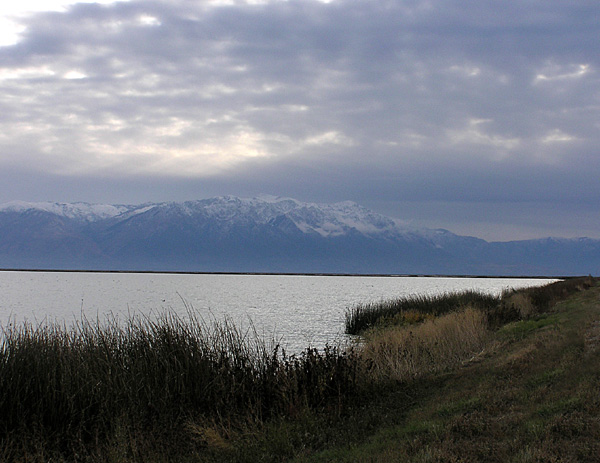 |
|
Bear River MBR |
2. Bear River Migratory Bird Refuge
If you like waterfowl (and shorebirds) this federally managed refuge is a must
see place. Thousands of ducks, i.e., Northern Pintail, Northern Shoveler,
Green-wing Teal, and Gadwall can be observed during migration. Flocks of Marbled
Godwits, Long-billed Dowitchers, Willets and peeps cover the mudflats during the
same time. During the late spring and into the summer you can observe the
courtship antics of the Western Grebe and also observe the colorful Ruddy Duck.
During the winter months, the unmistakable calls of thousands of Tundra Swans
fill the cold, crisp air. And its free.
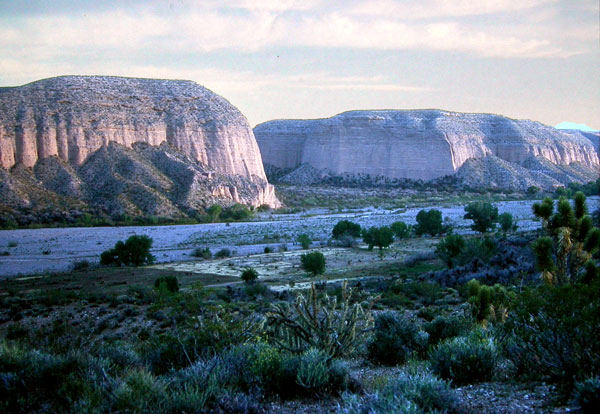 |
|
Beaver Dam Wash |
3. Beaver Dam Wash
There are about ten species of Mohave Desert birds that make their home in the
southwestern corner of the state. No one who is serious about keeping a state
bird list should die before visiting Lytle Ranch Preserve, owned by Brigham
Young University. Located northwest of St. George, the ranch can be accessed by
traveling on a graded gravel road once you leave the main highway at a place
that used to be called "Castle Cliff". Consult a map for directions. On the
drive to the ranch watch for Cactus Wren and Black-throated Sparrow as well as
the occasional Loggerhead Shrike which hunts from the tops of Joshua Trees.
Birds that can be found at the preserve include the uncommon Common Black Hawk,
White-winged Dove, Costa's Hummingbird, Phainopepla, Summer Tanager,
Black-tailed Gnatcatcher, Brown-crested Flycatcher, Verdin, Lucy's Warbler and
Bell's Vireo. April is the best time to visit because it isn't too hot, yet, and
the birds are vocalizing. But you need to be there early (before 10:00 AM) for
best results. Other species to look for are the Greater Roadrunner, Gambel's
Quail, Ladder-back Woodpecker, Crissal Thrasher, Blue Grosbeak and Hooded
Oriole. When the figs are rips as many as three species of orioles are possible
as they come in to feed on the ripe fruit. Persimmons ripen by late fall, and
the Red-naped Sapsuckers move in to feed on the fruit, which then attracts the
large, golden-winged Tarantula Hawks, wasps that feed on the juice made
accessible by the woodpeckers. At night listen for the Western Screech Owl,
Great Horned Owl and Common Poorwill. If you visit during fall migration,
eastern vagrants should be looked for. Lytle Ranch Preserve really is a jewel in
the desert.
4. Deseret Ranch
Located mostly in Rich County in northern Utah Deseret Ranch offers a great
diversity of birds and harbors one of the largest populations of Greater Sage
Grouse in Utah. The problem here is access--and I'm not referring to automobile
access. A couple of instate birders have purchased the "rights of admission" so
to speak. In order to check out the birds on the greater portion of the ranch a
fee is charged by the individual who serves as your guide on the property.
It is a great place to find unusual migrating birds, especially warblers and
shorebirds. But if you don't mind visiting other places in the state I will
mention you can find most of the same birds. It just takes longer. Depends on
the state of your health, I suppose.
5. Devil's Canyon Campground and Recapture Reservoir
In southeastern Utah, driving on State Highway 191 between Monticello and
Blanding takes the birder through extensive stands of Ponderosa Pine forest.
Devil's Canyon Campground is a favored stop along the way because finding three
species of nuthatches (Pygmy, Red-breasted and White-Breasted) is a real
possibility. Plus, this area is probably the most consistent location in the
state to observe the Acorn Woodpecker. Other woodpecker species to look for are
the Hairy, Downy and the Red-naped Sapsucker. A short distance farther south on
the highway toward Blanding is Recapture Reservoir, a favorite stop-over for
migrating water birds such as mergansers, grebes and Common Loons.
 |
|
Farmington Bay |
6. Farmington Bay Waterfowl Management Area
During the winter months, this state-managed waterfowl area is the best place in
the state to observe large numbers of Bald Eagles as they move in for a free
lunch of dead carp. Numbers seem to peak during the last of January to the
middle of February, so if you like watching eagles, this is the best time and
place to go visit. Located on the east shore of the Gt. Salt Lake this
management area is just a short drive from major population centers along the
Wasatch Front.
During your winter visit there are usually three or four species of gulls on which to practice your identification skills.
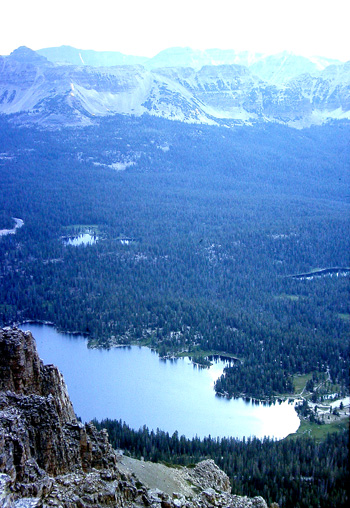 |
|
Mirror Lake from Mt. Baldy |
During the summer months watch for Common Moorhen, American Bittern, Virginia Rail and Sora. Much more common, though, are Marsh Wrens, Cinnamon Teal and Canada Geese, all of which are common nesting species.
7. The High Uintahs
For beautiful mountain scenery the drive east from Kamas on the Mirror Lake highway through forests of pinion-juniper, aspen, and finally spruce-fir is a favorite of most instate birders. Plus, this is the best location in the state to observe a variety of high alpine forest birds in a centrally located area. Around the Mirror Lake camping area, Gray Jay, Clark's Nutcracker, Pine Grosbeaks and Three-toed Woodpeckers are fairly easy to find. And at certain times of the year, with luck, the Black-rosy Finch can be observed foraging in the snowfields along Mt. Baldy pass. Red Crossbills and Pine Siskins can usually be observed in the tops of conifers where they extract seeds from the cones.
8. Quail Creek reservoir, Grandpa's (Stratton's) Pond and Hurricane Water
Treatment Ponds
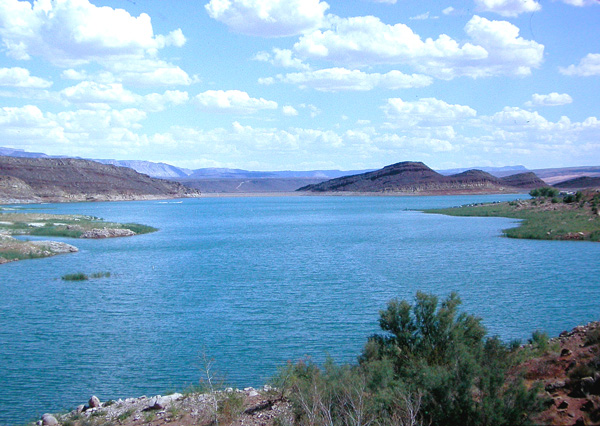 |
|
Quail Creek Reservoir |
Within a couple of miles of each other in the Virgin River drainage, and located between St. George and Hurricane in Washington County, are three man-made bodies of water which attract many different species of water birds, especially during the winter months. These are the places to go if you want to perfect your identification skills on ducks because most of them are here.
At Quail Creek reservoir diving ducks such as Common Goldeneye and Bufflehead are common. Double-crested Cormorants, Eared and Western Grebes, although not considered waterfowl, can also be observed.
Just to the south on the other side of the earth-filled dam is Stratton's, now called Grandpa's, Pond. There is always a good variety of waterfowl here such as Hooded Merganser, Greater and Lesser Scaup, American Wigeon, and an occasional Red-head or Canvasback.
And just to the southwest of this pond are the Hurricane water-treatment
ponds on which can be found rafts of Northern Shoveler, Ruddy Duck, and
Ring-necked Duck.
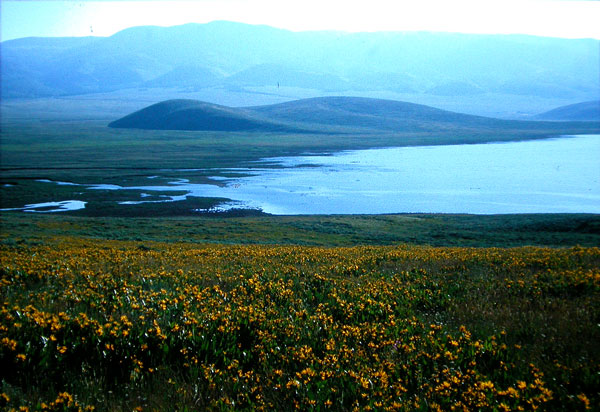 |
|
Strawberry Reservoir |
9. Strawberry Valley
Strawberry Valley in Wasatch County would be one of the first on my list of
"must visit" sites. This area not only has a lot of interesting birds, and is
only an hour's drive from Utah Valley, but it is a beautiful area to visit,
especially in the summer when a variety of mountain wild flowers are in bloom.
Centered in the middle of the valley is Strawberry Reservoir, one of the most
heavily fished bodies of water in the state. But Strawberry also attracts large
numbers of nesting Western Grebe, hundreds of American White Pelican, and many
species of waterfowl. Gravel roads along tributaries such as Clyde Creek, Mud
Creek, Bryant's Fork, Indian Creek, Co-op Creek, and Strawberry River provide
access to a mixed variety of riparian and forest birds such as Willow
Flycatcher, Pine Grosbeak, Fox Sparrow, House Wren, and if you are lucky,
Three-toed Woodpecker and Northern Goshawk. In the sagebrush-grass steppe
Brewer's and Vesper Sparrows are easy to observe. In the more moist areas
Sandhill Crane and Savannah Sparrows can be found.
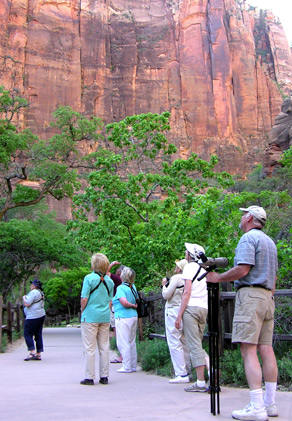 |
|
Birding at Zion NP |
10. Zion National Park
While enjoying spectacular scenery in the main canyon of Zion National Park look
for Plumbeous Vireo, Yellow Warbler, Black-headed Grosbeak and the Peregrine
Falcon which hunts from high vantage points overlooking the canyon floor. Along
the Narrow's Trail look for the Painted Redstart, one of the few places in Utah
where this species has nested regularly in the last four years. Take a trail on
the east side of the mile-long tunnel and watch White-throated Swifts zip by at
eye level and listen for the cascading song of the Canyon Wren. Then take the
East Rim Trail through Ponderosa Pine parkland near the eastern boundary of the
park and watch for Hairy Woodpecker, Red-breasted Nuthatch, Pygmy Nuthatch and
the beautiful Grace's Warbler.
During the winter, if you should be inclined to visit when there aren't
hordes of visitors to contend with, Winter Wren has been found at the waters
associated with Weeping Rock. Watch for Dippers in the Virgin River. And
sometimes, near and around the campgrounds and visitor's center Pygmy Owls have
been found. There is a fee to enter the park, but in my opinion it is worth it,
at any time of the year.
Utah County Birders 2008 Birding Challenge
The three members of our birding community who have organized the contest for the last 2-3 years have indicated they need a rest. So, here is a suggested format. It may need a bit of "tweeking" by suggestions from some of you, but otherwise, I think the following should be fun and challenging.
Categories for the 2008 Utah County Birders' Birding Challenge:
Gold Medal
Bird Species
1. Find 8 species of raptors in each of 8 different Utah counties
2. Find 8 species of waterfowl in each of 8 different Utah counties
3. Find 8 species of shorebirds in each of 8 different Utah counties
4. Find 8 species of tyrannids (flycatchers, kingbirds) in each of 8 different
Utah counties
5. Find 8 species of the family Parulidae (warblers) in each of 8 different Utah
counties
6. Find 8 species of the family Emberizidae (sparrows and towhees) in 8
different Utah counties
Utah Bird Habitats
1. Find 8 species of birds in a riparian community
2. Find 8 species of birds in a residential area
3. Find 8 species of birds in a fresh water or marsh community
4. Find 8 species of birds in a spruce-fir community
5. Find 8 species of birds in a pinion-juniper community
6. Find 8 species of birds in an agricultural area
7. Find 8 species of birds in an aspen-oak-maple community
8. Find 8 species of birds in a salt water community
Utah County Trails
1. Find 8 species of birds along the Provo Canyon Trail
2. Find 8 species of birds along the Jordan River Trail
3. Find 8 species of birds along the Bonneville Shoreline Trail
4. Find 8 species of birds along the Skipper Bay Trail
5. Find 8 species of birds along the Lower Provo River Trail
6. Find 8 species of birds along the Hobble Creek Canyon Trail (east of
Springville)
7. Find 8 species of birds along the Provo Airport Dike
8. Find 8 species of birds along the Rock Canyon Trial
Miscellaneous Category
Complete any 8 of the following:
1. Add 8 new or "life" birds in the state of Utah
2. Add 8 new or "life" birds in the contiguous 48 states
3. add 8 new or "life" birds in the fifty states
4. See or add 8 new or "life" birds in a foreign country
5. Add 8 new birds to your yard list
6. Visit 8 different states and add 8 species to your state life list in each
state visited
7. Attend 8 meetings of the Ut. County Birders during this year
8. Provide directions to 8 new locations to go birding in the state on the Ut.
Birds website
9. Contribute 8 photos of Utah locations to go birding to be added to Ut. Birds
website
10. Introduce 8 new people in the community to birding by bringing them on
fieldtrips or to the meetings
11. Volunteer to lead two UCB field trips to a local county location
12. Give a school presentation on birds at least twice during the next twelve
months at which there are at least 8 students in attendance each time
13.Volunteer to serve as a scout merit badge counselor in your church for the
bird study merit badge
14. Write two articles for the newsletter
For the silver medal:
Do half of the number for each of the preceding categories
to earn recognition for the silver medal.
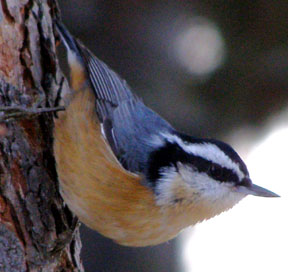 |
|
photo by Marlene Foard |
Red-breasted Nuthatch
Sitta canadensis
by Glenn Barlow
I have chosen as this month’s bird the Red-breasted Nuthatch, Sitta canadensis. Before beginning this short study I first wanted to know how many nuthatches species there might be and where they are located.
In the current 6th Edition (June 2007) of The Clements Checklist of Birds of the World, there are listed 24 species of nuthatches. However, in the Fifth Edition of the National Geographic Field Guide to the Birds of North America, it lists 25 species with four in North America. This family of birds is found world-wide in temperate coniferous and deciduous forests. I was surprised to find that most species are found in Eurasia, including Greece, Turkey, Russia, North and South Korea, China and the southeast Asian countries. One is also found on the island of Corsica, one is endemic to Algeria and one to The Philippines.
The most common and widespread nuthatch is the Eurasian or Wood Nuthatch, which is found in temperate Europe and Asia. One of the rarest of nuthatches is the Beautiful Nuthatch, which is found in northeast India and neighboring regions. In all but a few of the nuthatches, the dark eye stripe seen on the Red-breasted is prominent in this family. Except for perhaps the rock nuthatches, you will find all the nuthatches feeding in a similar manner in trees.
What makes this bird, including the Red-breasted, so different? These acrobatic little birds are the only tree-trunk forager that habitually hunts with their head downward. They live largely on the insects and spiders they are able to find in the nooks and crannies in the bark. Their bills are thin, straight, and sharp-pointed, and their legs are short and stout. Unlike the woodpeckers and true creepers, they do not use their tail in climbing, but rely entirely on their feet to hold them in place.
Because of the number of Red-breasted Nuthatches being seen at our feeders, there appears to be an irruption year for this nuthatch. I have seen more this year at my feeder, than in previous years, and others have reported the same. This nuthatch’s tendency to come to our feeders is typical of this family. Sometimes they seem quite tame and indifferent to humans. At the feeder they will feed on black oil sunflower seed, peanuts and suet.
If we might play a Northern Pygmy Owl or Northern Saw-whet Owl call, to try and locate these little owls, one of the first birds to respond fairly quickly is the Red-breasted Nuthatch. Even if we cannot at first see it, we hear its soft, nasal and monotonous "yank, yank, yank." If we follow the call we might even see one of these owls. When we find this nuthatch it will invariably be hanging upside down at the end of a limb. It will often be found in the company of other small birds such as kinglets and chickadees.
This bird, like other nuthatches, is a cavity nester and uses natural holes in trees. Both parents work to line the nest with grass, moss, and animal hair. The number of eggs may vary from 4 to 10. They are white, speckled with red-brown.
For sources on nuthatches and the Red-breasted Nuthatch see the following sources:
1. Pete Dunne’s Essential Field Guide Companion (2006)
2. The Audubon Society Encyclopedia of North American Birds (1995), John K Terres
3. National Geographic Field Guide to the Birds of North America, Fifth Edition
A Summary of results of the 2007
Provo Christmas Bird
by Merrill Webb, compiler
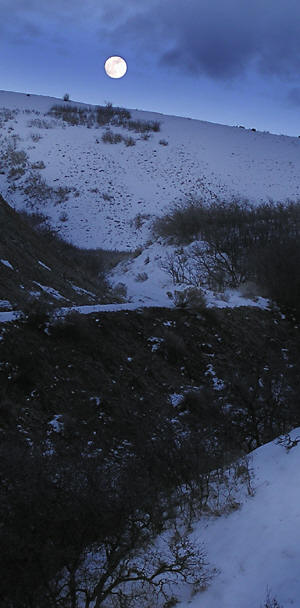 |
|
End of the day at the Northeast edge
of the Provo CBC Circle - 22 Dec 2007 |
Forty-four paid observers spent a combined total of 135 hours and drove a
combined total of 591 miles in our count circle December 22 to count 101 species
of birds on the 35th consecutive Provo, Utah Christmas Bird Count. The species
with the highest number of individuals was the European Starling with 11,863. No
surprise there. A distant second was the American Robin with 1827 individuals
counted, then Mallard with 1661, followed by the House Sparrow with 1005.
Sixteen species of waterfowl were observed; Mallards (as previously mentioned)
had the highest total followed by the Canada Goose with 748. With most available
water frozen solid the total numbers of waterfowl were down from last year. Ten
species of diurnal raptors and three species of owls were observed with the
American Kestrel having the highest number at 68, followed by the Red-tailed
Hawk with 62. Additional falcons were represented by one Prairie Falcon and 8
Merlins.
Two unusual species were observed, a Mute Swan and a Ringed-Turtle Dove. Both will be included in the totals, but will be listed as "exotics" in the final analysis. So, officially, our final count will be 99 species.
In the preceding four years, the Eurasian Collared Dove has been seen by just one group of observers, always in the Lake Shore area. This year four different groups observed this species in their area and a total of 80 were counted, an increase over the previous year's totals. And Mourning Doves were represented by 155 individuals, also an increase over previous years. So, maybe the Eurasian Collared Dove won't replace the Mourning Dove. Time will tell.
Other birds of interest included more than 100 Sandhill Cranes, 23 Brown Creepers, 4 White-breasted Nuthatches, one Winter Wren, 2 Northern Shrike, 739 Cedar Waxwing, 239 Bohemian Waxwing, 9 American Tree Sparrows, one White-throated Sparrow, 165 Gray-crowned Rosy-Finch, 25 Black Rosy-Finch and 7 Red Crossbills.
Four birders got a jump on the day's activities by getting in three hours of owling before sunrise. Thanks to Ned Hill for getting up early, braving the cold and leading a group to find Western Screech and Gt. Horned Owls. Temperatures ranged from 16-31 degrees during the 24 hour count time.
I also appreciated the three individuals who sent in results from observing their feeders.
Hopefully you read the accounts of the Provo CBC in the Sunday morning editions of either the Daily Herald or the Deseret Morning News, both of which gave us pretty good coverage. Especially liked the picture of Harold Clayson "chumming" gulls at an Orem park.
One group watched a Sharp-shinned Hawk "take" a magpie out of the air;
another group saw a Cooper's Hawk strike either a House Finch or a House Sparrow
at a line of feeders in southwest Orem. Thanks to all of you who helped with the
count. It is greatly appreciated.
Backyard Bird of the
Month
December 2007
Steve Carr - Holladay
All 3 Carduelins - 40 individuals, approximately equal numbers of each
species.
Lynn Garner - Provo
This time it was a Steller's Jay going from feeder to feeder.
Alona Huffaker - Springville
The Northern Pygmy-Owl that visited for awhile on Dec. 10. The many
chickadees harassing him are to be thanked for bringing him to my attention!
Eric Huish - Pleasant Grove
Bald Eagle - Soaring in circles high over the neighborhood.
Milt Moody - Provo
Red-breasted Nuthatch - nice to see again.
Carol Nelson - Provo
Three December favorites: The Northern Goshawk again on the 10th, the
Bald Eagle's yearly debut, and for shear numbers, 175 to 200 Canada Geese.
It's beginning to look a lot like Christmas.
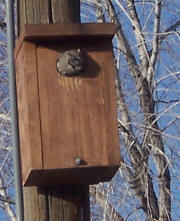 |
|
LeIla's Owl |
LeIla Ogden - Orem
A Western Screech-Owl has been sunning in my owl box again. I hope it
stays till nesting season. I'd love to see baby owls.
Cheryl Peterson - Provo
Pine Siskin - This is only the second one I've had this year. I used to
have large flocks.
Tuula Rose - Provo
A brief visit from a Merlin to the tree above the feeders, scattering all
the regulars in a hurry. Yard bird # 69.
Dennis Shirley - Bitburg, Germany
How about a Eurasian Green Woodpecker - Only one seen in Darren's yard
since we've been here [Bitburg, Germany].
Alton Thygerson - Provo
Mountain Chickadee - first seen in 30 years.
Bonnie Williams - Mapleton
Townsend's Solitaire - only second time I've had one in my yard.
We would like you to share your favorite backyard bird each
month. Please send your favorite bird at the end of the month to newsletter@utahbirds.org
or call 360-8777.
Membership Dues:
The new year is here. While you're paying Christmas bills, put your $15.00 dues in an envelope and mail them to:
Carol Nelson
2831 Marrcrest West
Provo, Utah 84604
They will give you a handheld copy of the newsletter, and help support our web
page. Thank you.